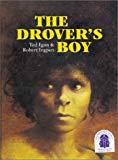‘The Drover’s Boy’ is based on a poignant song written by Ted Egan (1981), which in turn was based on an old ballad about a drover married to an Aboriginal woman at a time when marriage between a white Caucasian and an Aboriginal person was illegal in Australia. Aboriginal women were also denied employment as drovers. It was not uncommon from the late nineteenth century until the 1950s for a drover and his Aboriginal wife to hide their relationship by disguising her as a ‘drover’s boy’. She had to bind her breasts, cut her hair, and change her name to disguise herself. These stockwomen played a significant role in Australia’s pastoral industry and their contributions are honoured in this text.
Robert Ingpen’s artwork for this book is multi-layered and exquisite in its rendering. The cover contains a wistful and strikingly beautiful portrait of a drover’s boy. Her watchful eyes suggest that her life was never a peaceful one, as she must always have lived in fear of being found out and separated from her partner. The endpapers contain a painterly depiction of a bird flying over the landscape as the sun is setting over a shadowy image of the progress of a droving team at dusk, with horizontal lines suggestive of Aboriginal iconography. The title page contains an enigmatic portrait of a figure with hat pulled down obscuring the face – a poetic expression of the plight of these women doomed to ‘hide in plain sight’ throughout their lives and careers. The pages contain the text of the song opposite insightfully selected fragments of historical written texts and photos which reflect and illuminate the social context of the times. These pages are juxtaposed against alternating wordless double page spreads which contain magnificent paintings poetically depicting the life of the ‘drover’s boy’. The music is included at the back of the book with the words of the song. The final painting is another atmospheric tribute to the pioneering women who were asked to deny their gender and who worked so hard, side by side, with their partners.
The book closes with a note on the background to the text, including the tragic information that some of these women may have been kidnapped in the wake of massacres, albeit they later became devoted partners to their captors. This is a majestic and masterful tribute to an under-recognised aspect of Australia’s history.
Ted Egan AM is a well-known folk musician whose beautifully crafted song ‘The Drover’s Boy’ won the Heritage Award at the Australasian Country Music Awards in 1990 after it was recorded by John Williamson. Artist Bob Marchant has also created ‘The Drover’s Boy’ series of paintings inspired by the words, one of which won the Sulman Prize, 1994. Robert Ingpen AM, FRSA is the only Australian to have won the Hans Christian Andersen Award for Illustration (1986) and is internationally regarded as a fine artist and illustrator.

